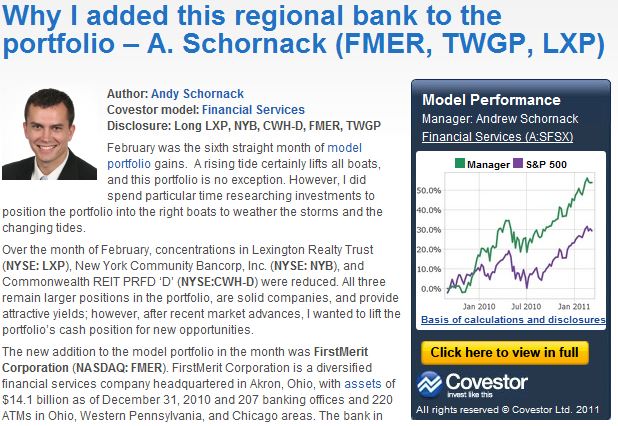Covestor Model manager James Hofmann’s Dividend Growth model has not only outperformed the S&P 500 for the past two months, but it has also managed a 9.24 percent return in July. We sat down with James to learn more about his investing decisions and to find out how he finds equities paying dividends in this economy.
Covestor Live: In July, your model outperformed the S&P 500—and that was during your first month as a model manager. To what do you attribute this success?
James Hofmann: I attribute the model’s success in July to two underling themes that I expect to continue. Theme one is the flight to safety being seen in the markets currently. The economic recovery in my opinion is in real danger and investors are going to leave those high beta cyclical names to return to more stable low beta non-cyclical names like health care and utilities. Essentially, this model is currently benefiting from sector rotation, being in the right sectors at the right time. Secondly, there is currently a major movement toward income producing investments. Investing in income producing equities in this upcoming prolonged no-growth economic period is the right move. I believe this trend will continue, thus driving up the price of the underling equities in this portfolio.
CL: Your model focuses on equities with a stable dividend. Do you find that fewer companies are paying a consistent dividend in this economy? Why or why not?
JH: When I am looking for a stable dividend I look at cash flows. I look for cash flows that can sustain or grow the current dividend. It is a tough time for consistent dividends as there are a lot of uncertainties in the market; however, many corporations have been hoarding cash and they will eventually need to pay it out. I also want to point out that I am not completely opposed to a dividend cut if I feel shareholders will benefit from it because of perhaps a new capital-intensive project that will generate higher future cash flows that can be paid out as dividends. I strongly believe in dividends in my investment philosophy and that is reflected in this model. “A bird in the hand is surely worth two in the bush,” is my view regarding dividends.
CL: In August you added Frontier Communications Corp (NYSE: FTR) to your model. What made you decide to add it?
JH: Frontier is one of my favorite stocks currently. Presently, it is making up 9% of the model and for good reason. FTR has strong cash flows, which can and will provide a safe dividend. FTR also has growth in its future with the successful acquisition of a large amount rural landlines from Verizon (NYSE: VZ). Buying FTR with its 9% dividend is one of those rare opportunities the market gives you and one I fully plan to exploit. I also believe FTR’s management has the expertise to integrate these Verizon assets and squeeze juicy margins out of them. Squeezing every dollar out of the lines to generate solid margins is one of FTR’s strong points, which ultimately derives that very high return on equity FTR has. This is the fundamental aspect to look for in a stock. I believe this stock is going higher and I expect this company to be the model’s largest holding going forward.
CL: You bought more shares of Merck & Co Inc (NYSE: MRK) in August even though it had been one of your bottom performers in July. What made you make this decision to add additional shares?
JH: In August, I increased my Merck & Co Inc position for several reasons. One of the primary reasons I like MRK is at its current valuation, it really presents an extraordinary opportunity for value investors. The stock is heavily undervalued by historical valuation metrics, has a cheap price to trailing earnings ratio of around 10, has an attractive dividend yield of around 4.4% (CL Note: As of September 3, 2010 MRK had a 4.28 percent dividend yield.), and MRK has a great historical return on equity. I also believe with it acquisition of Schering-Plough (SGP), it has some growth in its pipeline. Overall, I am bullish on the sector and when it pick up, MRK will lead the pack. Merck is the prescription for equity gains that a wise investor should be seeking.
CL: You maintain 5-10 percent of the model in cash for, “market timing purposes.” What kind of market events do you try to capitalize on?
JH: I like to have some cash in the portfolio to take advantages of value opportunities the market creates. These opportunities may include a selloff in a good value name after a bad earnings announcement or just an out-of-favor sector. I also like to have the cash position so I can employ some sector rotation techniques as the general market and economy change. I use this cash portion so I can dollar cost average in and out of names and avoid exposure all at one price level. The cash position has worked very well so far for the model and I look forward to using it to take advantage of inefficiencies in the market.


